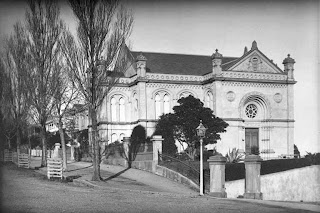Former Synagogue on Princes Street

The first Hebrew congregation began worship in Auckland in 1843. Their first formal place of worship was located in Nathan & Joseph's Warehouse in Shortland Street. By 1853 the congregation had grown to 100 and worship was held in a small building in Emily Place. By the 1860s this building had become too small for the rapidly increasing Jewish population and funds were raised for the construction of a synagogue. In 1884, the Jewish Community purchased a section on the corner of Princes Street and Bowen Street. At that time the site was occupied by the former Albert Barracks Guard House, which overlooked a vegetable garden, which had formerly been used by soldiers. Ref: 1-W136, the Jewish Synagogue in 1900, Sir George Grey Special Collections








